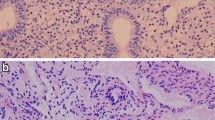Abstract
The effect of oral administration of indomethacin (100 mg/day), a potent inhibitor of prostaglandin (PG) biosynthesis, on the PG levels and cellular profile in the uterine flushings in response to the use of an IUD (Lippes Loop size C) was studied in sixty women. Indomethacin reduced the cell counts in both follicular and luteal phases of menstrual cycles before and after IUD insertion. The anti-inflammatory drug decreased PGE2 and PGF2alpha levels in both phases of the cycle before IUD insertion. After insertion, it inhibited only the formation of PGF2alpha and its 13,14-dihydro-15-keto metabolite in the luteal phase but not in the follicular phase. In long-term users, however, the drugs reduced the levels of all PGs studied in the luteal phase and only PGF2alpha and its metabolite in the follicular phase. The implications of these findings in the mechanisms of contraceptive action of IUDs and their side effects are discussed.
Resumé
On a étudié chez 60 femmes les conséquences de l'administration par voie orale (100 mg/jour) d'indométhacine, puissant inhibiteur de la biosynthèse de la prostaglandine (PG), sur les niveaux de PG et le profil cellulaire dans les flux d'elimination utérine en résponse à l'utilisation d'un DIU (stérilet de Lippe, taille C). L'indométhacine a réduit le nombre des cellules tant pendant la phase folliculinique que pendant la phase lutéinique des cycles menstruels avant et après l'insertion du dispositif. Cet anti-inflammatoire a fait baisser les niveaux de PGE2 et de PGF2alpha au cours des deux phases du cycle avant l'insertion du stérilet. Après l'insertion, il n'a inhibé que la formation de la PGF2alpha et de son métabolite 13,14-dihydro-15-cétone pendant la phase lutéinique mais non pendant la phase folliculinique. Toutefois, chez les utilisatrices de longue date, ces substances ont fait baisser les niveaux de toutes les prostaglandines étudiées pendant la phase lutéinique et de la seule PGF2alpha et son métabolite pendant la phase folliculinique. Cet article examine les liens entre ces constatations et les mécanismes de l'action contraceptive des DIU ainsi que leurs effects secondaires.
Resumen
En sesenta mujeres se estudió el efecto de la administración oral de indometacina (100 mg/día), un potente inhibidor de biosíntesis de prostaglandina (PG), en los niveles de PG y en el perfil celular en lavados uterinos, en respuesta al uso de un DIU (Asa de Lippes, tamaño C). La indometacina redujo el contaje celular en ambas fases, folicular y luteal, de los ciclos menstruales antes y después de la inserción del DIU. La droga antiinflamatoria disminuyó los niveles de PGE2 y PGF2alpha en ambas fases del ciclo antes de la inserción del DIU. Después de la inserción solamente inhibió la formación de PGF2alpha y sus 13,14-dehidro-15-keto metabolites en la fase luteal pero no en la fase folicular. Sin embargo, en las usuarias a largo plazo las drogas redujeron los niveles de todas las PG estudiadas en la fase luteal y solamente la PGF2alpha y sus metabolites en la fase folicular. Se discutieron las implicaciones de estos hallazgos en el mecanismo de la acción anticonceptiva de los DIU y sus efectos colaterales.
Similar content being viewed by others
References
ToppozadaM. and HafezE.S.E. (1980). The role of prostaglandins in the mechanism of action and the side effects of IUDs. InMedicated Intrauterine Devices. Physiological and Clinical Aspects. E.S.E.Hafez and W.A.A.VanOs, eds., Martinus Nijhoff Publishers, The Hague, pp. 84–97
KaleyG. and WeinerR. (1971). Effect of prostaglandin E on leukocyte migration.Nature New Biol.,234, 114–15
MyattL., ChaudhuryG., GordonD. and ElderM.G. (1977). Prostaglandin production by leucocytes attached to intrauterine devices.Contraception,15, 589–99
VaneJ.R. (1971). Inhibition of prostaglandin synthesis as a mechanism of action for aspirin-like drugs.Nature New Biol.,231, 232–5
ToppozadaM. (1985). Prostaglandins and their inhibitors in IUD induced bleeding. In:Intrauterine Contraception: Advances and Future Prospects, G.Zatuchni, A.Goldsmith and J.J.Sciarra, eds., Harper and Row Publishers, Philadelphia, pp. 319–334
NygrenK.G. and RyboG. (1983). Prostaglandins and menorrhagia.Acta Obstet. Gynecol. Scand. (Suppl),113, 101–3
RoyS. and ShawS.T. (1981). Role of prostaglandins in IUD associated uterine bleeding. Effect of a prostaglandin synthesis inhibitor (ibuprofen).Obstet. Gynecol.,58, 101–6
El-Sahwi, S., Toppozada, M., Kamel, M., Gaweesh, S., Riad, W., Ibrahim, I. and El-Sabbagh, H. (1987). Prostaglandins and cellular reaction in uterine flushings, I. Effect IUD insertion.Adv. Contracept., (in press)
DiRosaM. and WilloughbyD.A. (1971). Screens for anti-inflammatory drugs.J. Pharmacol.,23, 297–8
TomlinsonR.V., RingoldH., QureshiM.C. and ForchielliE. (1972). Relationship between inhibition of prostaglandin synthesis and drug efficacy. Support for the current theory on mode of action of aspirin-like drugs.Biochem. Biophys. Res. Commun.,46, 552–9
DamarawyH. and ToppozadaM. (1976). Control of bleeding due to IUDs by a prostaglandin biosynthesis inhibitor.IRCS,4, 5
ToppozadaM. (1978). Treatment of increased menstrual blood loss in IUD users.Contraception,36, 145–57
GuillebaudJ., AndersonA.B.M. and TurnbullA.C. (1978). Reduction by mefenamic acid of increased menstrual blood associated with intrauterine contraception.Br. J. Obstet. Gynaecol.,85, 53–7
Author information
Authors and Affiliations
Rights and permissions
About this article
Cite this article
Toppozada, M., El-Sahwi, S., Kamel, M. et al. Prostaglandins and cellular reaction in uterine flushings. II. Effect of PG synthesis inhibition in IUD users. Adv Contracept 3, 303–313 (1987). https://doi.org/10.1007/BF01849286
Received:
Revised:
Accepted:
Issue Date:
DOI: https://doi.org/10.1007/BF01849286



